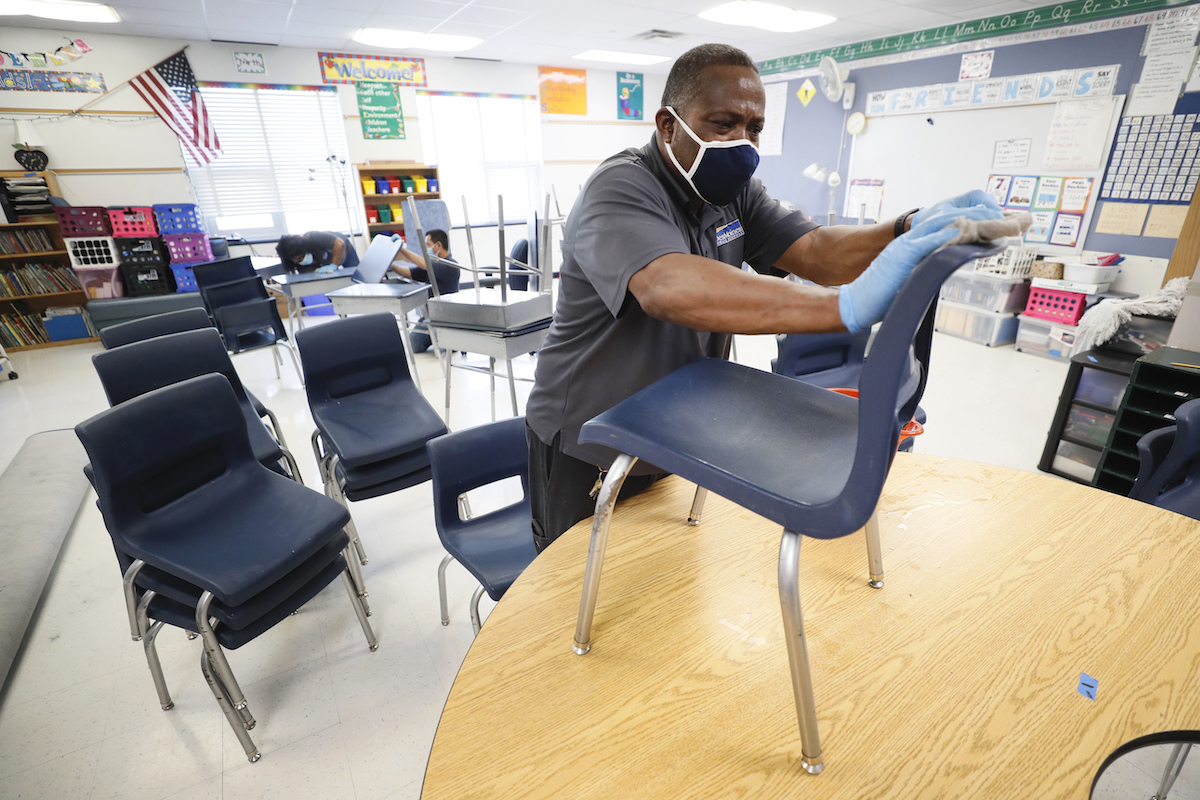

Des Moines Public Schools custodian Tracy Harris cleans chairs in a classroom at Brubaker Elementary School, Wednesday, July 8, 2020, in Des Moines, Iowa. (AP Photo/Charlie Neibergall)
PHOENIX — Tangled up in the controversy over how quickly children should return to the classroom given the pandemic is the still largely unappreciated catastrophic damage that’s been done to our education system, especially when it comes to low-income communities of color.
On February 11, the U.S. Centers for Disease Control and Prevention made a lot of people unhappy when it released its guidelines on how to get our kids back to school by stating the scientifically obvious: we can’t send children or teachers back to the classroom until it’s safe to do so.
“Under the [CDC] rubric laid out, the CDC recommends either fully remote or hybrid plans, where students spend some time in school and some at home, for areas with substantial community spread,” the Washington Post reported. “Even though [COVID-19] case counts are falling, the definition of substantial spread today includes the vast majority of the country.”
In other words, it’s still dangerous as hell out there.
What has many people so upset is that the CDC’s Guidelines weren’t titled: “Three Easy Steps for How to Get Our Kids Back in School Today!” But don’t blame the CDC. Blame the negligence and ineptitude of the last White House administration.
The truth is that none of this is easy. We’re in a global pandemic, the worst the planet’s lived through in 100 years, 500,000 Americans are dead, and there are still nearly 2,000 people a day in the U.S. dying from the disease.
As for getting our kids back in school, it doesn’t help that President Joe Biden keeps wishing out loud that he’d love nothing more than to see all of our kids back in school by April or May.
Mr. President, with all due respect, that’s not going to happen.
You’ve been in an office all of a month, and, yes, your team’s COVID-19 response has been night and day compared to the last bunch in the White House. But the only way most of our kids will be physically back in their classrooms before the summer break is if you were to order every teacher in the country to get vaccinated in the next 30 days.
Again, that’s just not going to happen.
Teachers work for local school districts, which are ultimately overseen by the states, whose governors, Democrat or Republican, are all over the place when it comes to deciding who to vaccinate and when. For better or for worse, that’s the way things are, and not even the president’s desperately needed $1.9 trillion economic stimulus package is going to change that, at least not right away.
So, the conversation we should be having is about how to ensure schools from coast to coast are safe enough to reopen at full capacity in the fall, and how to make up the precious educational ground that’s being lost every day to the pandemic.
Let’s keep in mind that long before today’s health crisis and mass school shutdowns, the U.S. was already lagging behind other leading industrialized nations when it came to teaching math, science and reading, according to Pew Research Center.
Yes, we still have some of the greatest universities in the world, but the cost of higher education is increasingly out of reach for average Americans, which helps explain our massive student debt load, and our K-12 education pipeline is full of clogs and cracks.
To make matters worse, the communities falling through the biggest cracks are usually low-income and especially low-income students of color, all at a time when the U.S. wealth gap is widening, and our nation’s population is only decades away from majority-minority status.
As has been widely reported, the devastation that COVID-19 has inflicted on communities of color has been crushing. Not only are infection and death rates among Blacks, Latinos and Native Americans two to three times higher than for whites, but only a fraction of those in our communities of color as compared to whites have been vaccinated.
While almost everyone’s kids are falling behind in school because of the pandemic, a recent study by McKinsey & Company. found that children of color are losing ground at about twice the rate of their white counterparts.
“To catch up, many students will need step-up opportunities to accelerate their learning,” the McKinsey report concluded. “Now is the time for school systems to prepare post-pandemic strategies that help students to meet their full potential.”
The reasons should be obvious. Low-income children of color tend to live in households where parents cannot afford to quit work and become pop-up homeschool teachers. Having less access to a computer or high-speed internet is a major barrier to remote learning. Low-income parents also are more likely to have front-line, essential jobs in the service industry, which have been especially hard hit during the pandemic. And poorer families, children and all, have been among the first to be evicted if they fall behind on the rent or mortgage, according to housing data gathered by the Latino advocacy group, UnidosUS.
Failing to help students, all students, but especially those more likely to fall behind is not just bad for our children’s future education and job prospects, but it will only guarantee that our nation’s already lagging educational system —which, flaws and all, is still the backbone of our economy— will only fall further behind.
***
James E. Garcia is a journalist, playwright and communications consultant based in Phoenix, AZ, the editor and publisher of the weekly newsletter Vanguardia America, and author of the upcoming book “Vanguardia: The American Latino Renaissance & the Future of Our Nation.” Twitter: @JG_Vanguardia.


